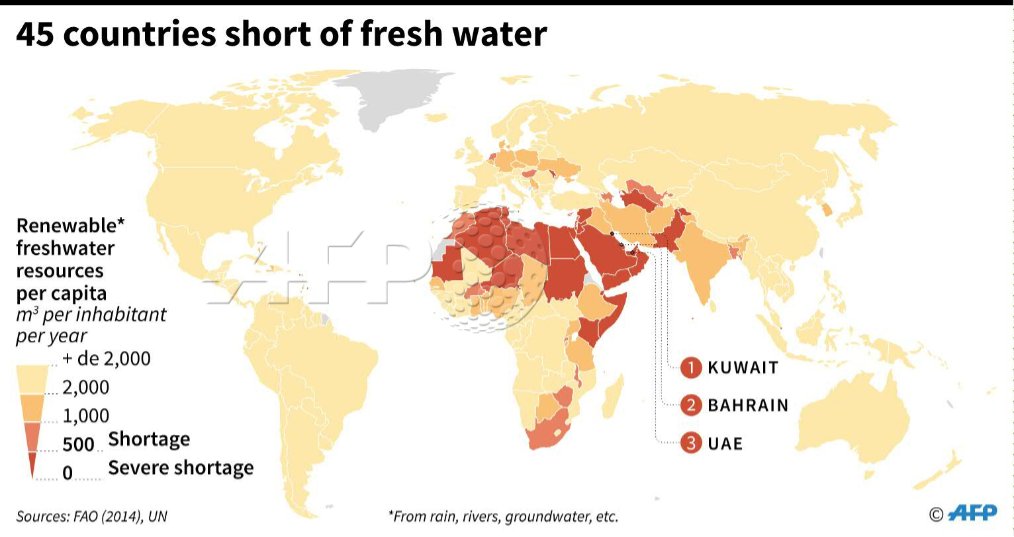The United Nations announced on Monday that the governments of all countries should focus on ‘greener’ policies to improve the supply and quantity of water as global warming and growing population is becoming a threat to water security and could impact billions of people.
Nearly 3.6 billion people – almost half of the world’s population – live in areas with a scarcity of water for at least a month every year, states UN’s 2018 World Water Development Report.
The report also comes in with a warning that by 2050, the number would rise to 5.7 billion.
“If we do nothing, some five billion people will be living in areas with poor access to water by 2050,” said UNESCO Director General, Audrey Azoulay, at the presentation of the report in Brasilia. She added,
This report proposes solutions that are based on nature to manage water better. This is a major task all of us need to accomplish together responsibly so as to avoid water-related conflicts.
The report also states:
Global water use has increased by a factor of six over the past century and continues to grow steadily at a rate of about one percent per year.
It is expected that the use of water is likely to increase due to population growth, economic development and changing consumption patterns, among other factors. The report adds,
The vast majority of the growing demand for water will occur in countries with developing or emerging economies.
Alongside this, due to climate change, the global water cycle is intensifying “with wetter regions generally becoming wetter and drier regions becoming even drier.”
Ecosystem-Friendly

So-called “grey” or man-made water infrastructures – such as reservoirs, irrigation canals and treatment plants – are no longer sufficient to meet these challenges, said the report’s editor-in-chief, Richard Connor.
The UN also argues that there is very little room to build up more reservoirs due to silting, environmental concerns and restrictions. Also the fact that the most cost-effective and viable sites had already been used in many developed countries.
In many cases, more ecosystem-friendly forms of water storage, such as natural wetlands, improvements in soil moisture and more efficient recharge of groundwater, could be more sustainable and cost-effective than traditional grey infrastructure such as dams.
Nature plays a unique and fundamental role in regulating the different functions of the water cycle.
The one thing that can act as a regulator, cleaner and water supplier is a “nature-based solution”. The report further stated that greener solutions were giving better results.
For example, in New York, three largest water-sheds that supply water to the city since late 1990s are protected by forest preservation programs.
“Disposing of the largest unfiltered water supply in the US, the city now saves more than $300 million (245 million euros) yearly on water sea treatment and maintenance costs,” the UN said.
ALSO READ
This Startup is Designing Low Cost Water Filters for the Poor In Pakistan
Another great example would be “the Sponge City” in China.
Apart from that, China has been planning to build 16 pilot projects across the country. The aim is to recycle 70% of rainwater by using methods like greater soil permeation, retention and storage, water purification and the restoration of adjacent wetlands.
Feed More People
“These solutions are cost-effective and not more expensive than traditional systems”, said Connor.
Stefan Uhlenbrook, program coordinator at the UN World Water Assessment Forum suggested that to improve the water availability and quantity:
It is possible to increase agricultural production per hectare with better water management and thus feed more people.
In order to combat erosion, drought and flood risks, having a “green” infrastructure, to boost soil quality and vegetation, can be a good source of help.
“And indigenous peoples could be involved in implementation, something which was not the case in “grey” infrastructure,” the report stated.
At present, only additional use was made of these nature-based solutions.
“Accurate figures are not available”, but investments in these techniques “appear to be less than one percent… of total investment in infrastructure and water resource management,” – the report.
“They are often perceived as less effective because they are less visible”, says Connor.
Via: AFP





















